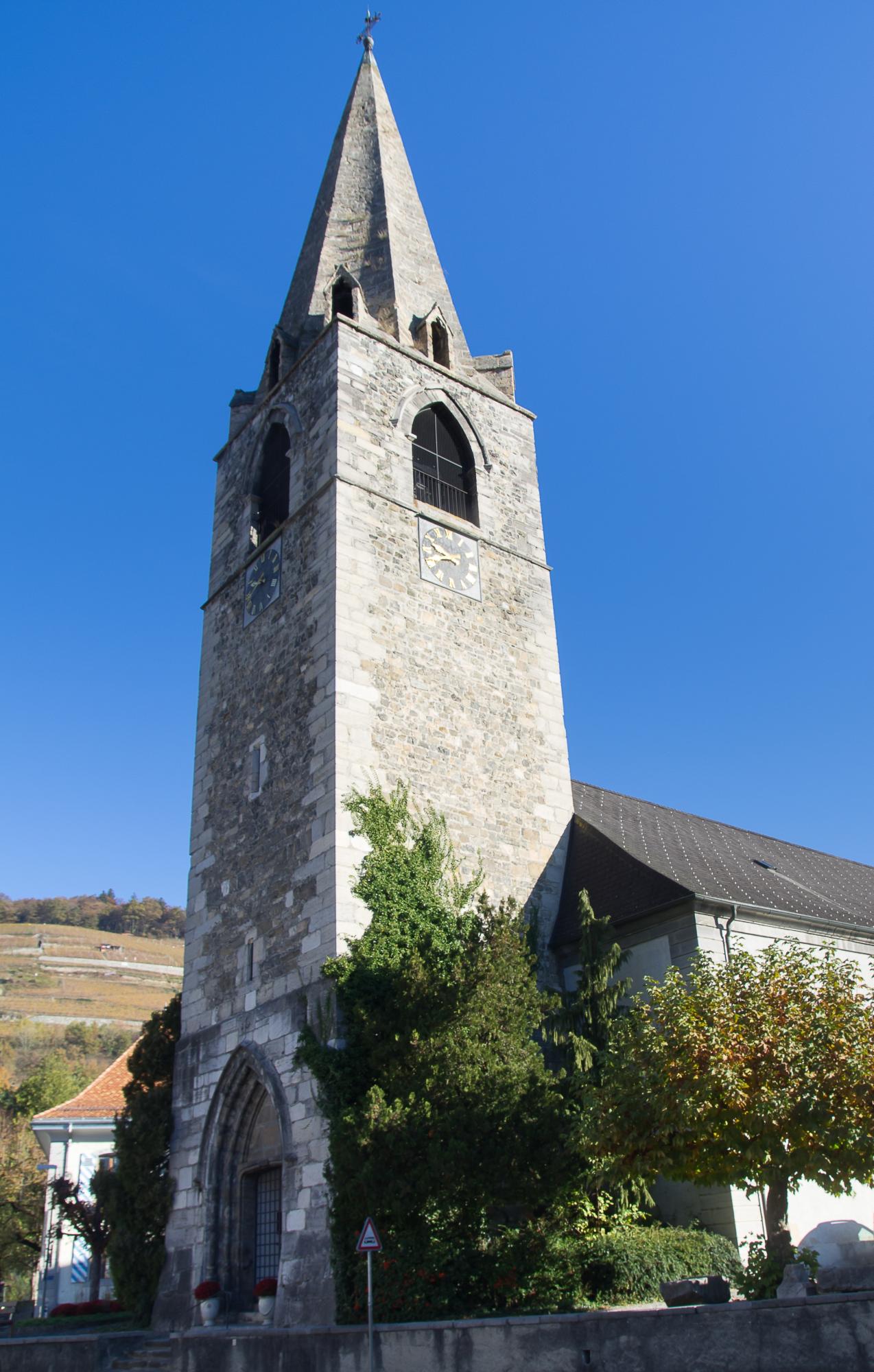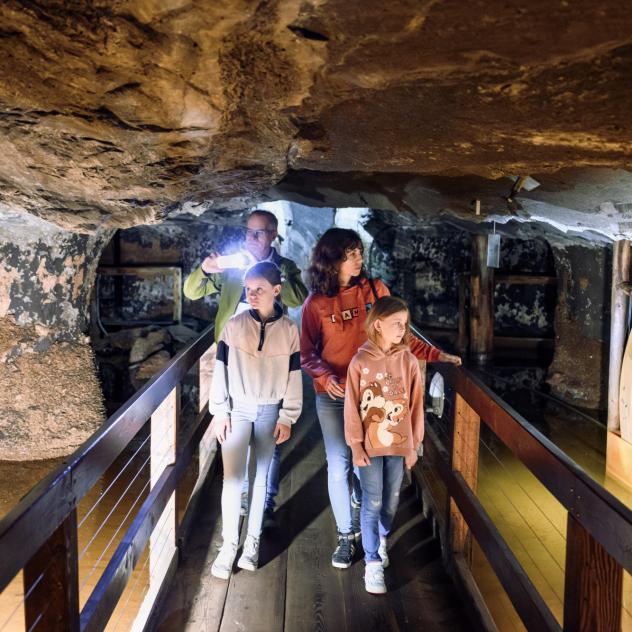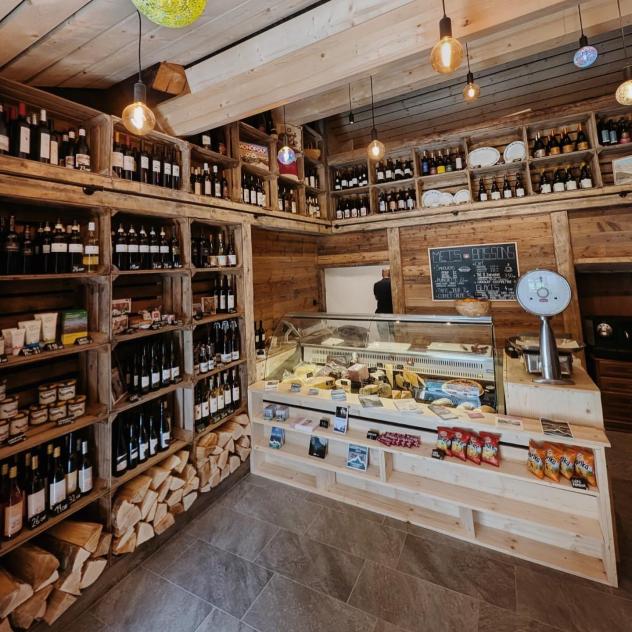

Overview
The first church in Bex was built in 1193. Dedicated to Catholic service until 1527, the temple became Protestant at the Reformation.
It currently consists of two distinct parts. The imposing bell tower-porch from the early 16th century is one of the most remarkable in the region and the second highest in the canton after that of Lausanne Cathedral; it was designed by Jean Vaulet Dunoyer. The nave, built in 1814, is also very original with its semicircular end, while its stained glass windows with Pre-Raphaelite tendencies, made by the English master glass artist Clement Heaton in 1911, are rare in the Protestant domain.
In 2009, excavations under the road in front of the porch uncovered several medieval tombs, indicating the presence of a cemetery around the church. The large limestone blocks on the right of the porch come from the Roman bridge built over the Rhône at Massongex.
Cited as early as 1193, the church in Bex underwent various construction and renovation phases in the Middle Ages, of which the imposing bell tower-porch remains today. It can be attributed to the "master of beautiful bell towers", Jean Vaulet Dunoyer, author of most similar towers in the region, notably in Montreux, Le Châble and Vollèges. The bell tower was consecrated in 1501. Built in the years 1501-1514, it is very simply composed of a square body, very high, pierced by a remarkable door on the ground floor and large pointed arch windows in the belfry. The door, typical of Dunoyer's style (see the portals of Saint-Martin in Vevey and the church in Vouvry) with its inscription of one arch within the other (an almost flat arch under the tympanum inscribes a carefully moulded pointed arch) precedes a small open porch which gives access to the door of the old church, again in pointed arch. The belfry level, which contains a bell dated 1413, has four large openings highlighted by a moulded stringcourse, which allow the sound to spread far and wide. Finally, the highlight of the composition, the octagonal spire is flanked at its base by eight stone dormer windows. Each of its sides is slightly concave, which highlights the finely worked edges and allows for a most refined play of light and shadow. Of the series of bell towers by Vaulet Dunoyer, this is undoubtedly the most accomplished - it is also probably the last of his production: the Protestant Reformation adopted shortly afterwards (on 5 March 1528, in Bex) put an end to the numerous religious works of the turn of the century. On 26 January 1946, the spire of the bell tower was damaged by an earthquake and repaired with money from a public subscription. A small room at the top of the bell tower housed the municipal archives until the end of the 1990s, where the registers could be consulted in the company of the pigeons that nested in the roof structure.
The old medieval nave, dark and narrow, did not serve the Protestants well, who had to make do with it. In 1791, a quarrel arose over the pews in the church: the Bernese nobles were reproached for the privilege of having their names inscribed on the front pews. At the same time, a reconstruction project was launched, but it was not successful: the French-born architect Charles Bippert produced a first project that was rejected. In 1806, a fire affected the temple, which threatened to collapse. To repair it, a communal collection was launched and the heads of the village families were obliged to work for free on the repair of the temple for 24 days each, using only local materials, which were less expensive. The architectural project chosen was signed by the quasi-official architect of the young cantonal state, Henri Perregaux. He was responsible for the present nave, which was built in 1813-1814; it is characterised by its vast volume covered by a vault initially planned in gypsum and, above all, by its semicircular "choir", which was quite unique at the time in Reformed architecture. It may evoke the Grand Temple of La Chaux-de-Fonds (1796) designed on an oval plan; otherwise, it is closer to the neoclassical Catholic churches of the time. On the outside, the decoration is sober but meticulous: the delicate writing of the door and window frames in cut stone, harmonious proportions, and the appropriateness of the form to the function are the main characteristics of this emblematic building.
In 2010, during civil engineering works, 120 medieval graves were uncovered under the road in front of the Temple porch. This cemetery dates back to the foundation of St Clement's Church in 1193 and appears to have been used until 1812.
For more information, see
Work of the art history research seminar of the University of Lausanne, under the direction of Prof. D. Lüthi, 2014.
F. Gillard, "Essai sur l'ancienne nef de l'église de Bex", Revue historique du Chablais vaudois (= Revue historique du Mandement) 3, 1980.
Website of the heritage of the Canton of Vaud:
http://www.patrimoine.vd.ch/archeologie/sites-archeologiques/moyen-age-le-cimetiere-de-bex/
Location
Getting to Bex
Car parks and transport
Brochures and maps
Practical information
- location_on
Office du Tourisme de Bex
Avenue de la Gare 68
1880 Bex
- phone_in_talk
+41 24 463 30 80
- mail
info@bex-tourisme.ch
Facebook
Instagram











